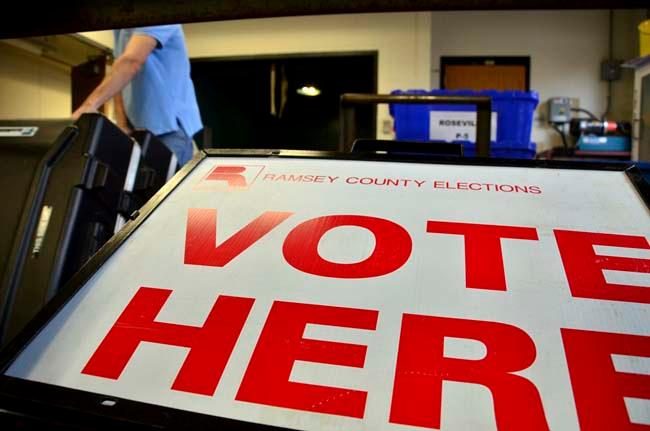Six candidates are running for three seats on the White Bear Lakes Area Schools board in November’s election.
General information about the Nov. 5, 2024, election is online at twincities.com/news/politics/elections including information on candidates for races in Ramsey, Dakota and Washington counties.
To find out what’s on your ballot, where to vote and other election information, visit the Minnesota Secretary of State’s elections page at sos.state.mn.us/elections-voting.
Scott Arcand (incumbent)
Scott Arcand. (Courtesy of the candidate)
Age: 60
What would your top priorities be if elected? My top three priorities are to foster safe, supportive school environments where every student can excel academically, to broaden career pathways that allow students to explore diverse career opportunities, and to build and nurture strong, vibrant connections with our community.
What qualifies you to hold this position? I bring 36 years of experience in education, having served as a teacher, coach, assistant principal, and curriculum specialist. I hold a Bachelor of Science in Business Education, a Master of Education in Teaching and Learning, and a Doctorate of Education in Leadership. With a deep understanding of learning and a genuine compassion for students, I have also contributed to the school board, serving as both Vice Chair and Clerk.
What do you think is the primary role of government? The role of government is to provide essential services like education, infrastructure, and healthcare, while protecting individual rights and freedoms.
How do you work to understand, and then learn from, opinions that differ from your own and people who disagree with you? To understand and learn from differing opinions, I prioritize listening for understanding and approach conversations with curiosity instead of formulating a rebuttal. I aim to genuinely grasp the reasoning and experiences behind the other person’s perspective by asking insightful questions and reflecting on their responses. Instead of viewing disagreement as a conflict, I see it as an opportunity for growth, often gaining new insights that broaden my own perspective.
Website or contact information: scottarcandforschoolboard.com/
Brian Cern
Age: 50
What would your top priorities be if elected? A major issue facing the school district is access. Let’s use food insecurity as an example. The number of families that would have otherwise qualified for free and reduced lunches but for breakfast and lunch are now provided at no cost to students and families is staggering. Providing equal access to meals eliminates one of the many areas of uncertainty that permeates our student’s lives. But access is bigger than that, the school district needs to provide a safe and supportive environment in which all students are respected regardless of demographics and background.
What qualifies you to hold this position? I’ve spent the past five years helping in elementary schools and have seen how a thoughtful, well-balanced approach can help our kids. When I started this process, I was disappointed to learn that not everyone shared my feelings about ensuring all children have access to a world-class education. I wish to continue the work of raising the bar, free of outside influence, so that all students may flourish and grow, finding themselves ready to face the challenge of an ever-changing world.
What do you think is the primary role of government? To facilitate the betterment of it’s population
How do you work to understand, and then learn from, opinions that differ from your own and people who disagree with you? Through discussion and collaboration. If you accept that we are after the same goals, then the only clear and reasonable path forward is through collaboration. The back and forth, give and take, will most often lead to the correct answer.
Website or contact information: cern4isd624.com
Tim Klecker
Tim Klecker. (Courtesy of the candidate)
Age: 40
What would your top priorities be if elected? Setting clearer student-outcome focused goals, increasing student compacities and proficiencies, responsible decisions making around the budget, and providing transparency with the public to establish trust and confidence.
What qualifies you to hold this position? I’m a certified financial coach with expertise in goal setting and achievement. I know what it takes to work as a governing body and set clear goals with defined objectives.
What do you think is the primary role of government? To safeguard the rights of its citizens, protect their freedoms, and take on the responsibility of looking after its citizens within the guidelines of the constitution.
How do you work to understand, and then learn from, opinions that differ from your own and people who disagree with you? In both my personal and professional life, I listen to understand rather than respond. I believe we all have more in common than we think, and often it is agendas that get in the way of commonality. I welcome insight and perspective from others.
Website or contact information: timklecker.com
Dan Skaar
Dan Skaar. (Courtesy of the candidate)
Age: 64
What would your top priorities be if elected? First, we need to focus on education in our strategic plan to improve academic proficiency and reverse the six-year trend of low academic proficiency and declining enrollment. Second, bring back transparency, truth and trust between the community and the school district. Policies around public comments need to change to be more welcoming for parents and the community. Today, the policies are designed to squelch public comments and obscure the board’s decision-making. Third, safe and peaceful schools. One of the biggest concerns of parents and teachers is disruptive behaviors in schools. It’s impacting teacher job satisfaction and student satisfaction. We need to balance effective discipline with the rights of all to have an education in a safe, peaceful environment.
What qualifies you to hold this position? I am the best candidate for the school board because of my commitment to maintaining strong links between our community and our schools. I want to ensure that my two grandchildren in our district enjoy the benefits of a strong education with abundant extracurricular activities as I did in my youth. I am grounded in my academics with a BA in Accounting and an MBA for St. Thomas. I am a licensed Certified Public Accountant in Minnesota. I have extensive experience in leadership positions with over 30 years serving K-12 schools, communities, and coworkers, I have led both for profit and nonprofit organizations. I have board experience. I have testified at state and federal agencies – I understand government and regulation. I support teachers, parents, and bringing accountability for our taxpayers to establish White Bear Lake Schools as a beacon for the metro area. We can have academic excellence and fiscal responsibility. I am the candidate to bring us together with fresh thinking and strength.
What do you think is the primary role of government? To serve its citizens and assure an orderly, safe society where its citizens can enjoy their individual freedoms.
How do you work to understand, and then learn from, opinions that differ from your own and people who disagree with you? Disagreements and differing opinions are the heart of learning, new ideas and innovation. We all share the same mission – educating our children and preparing them for the future. So, we must assume positive intentions from all parties. Being constructive in the discussions promotes more open, useful resolutions. My moto – first seek to understand and then to be understood.
Website or contact information: danskaar.com
R. Scott Smith
R. Scott Smith.(Courtesy of the candidate)
Age: 60
What would your top priorities be if elected? First, academic excellence. Grade-level proficiencies have declined for years beginning well before 2020. I am running to ensure the district is focused on improving student academic outcomes in alignment with the values of the community. Second, safety in the classroom. I will prioritize funding to support front-line educators. I will advocate for the consistent application of consequences with fair implementation to help restore order and respect for staff and school facilities. I will support policies that will provide resources for our teachers that will allow them to focus on what they do best. Third, transparency – every program should have clear and measurable student-based outcomes reported consistently and reviewed frequently to allow for corrections over the measured time period. I will be a liaison between residents and the administration to ensure that the communities concerns are heard and addressed.
What qualifies you to hold this position? I am a 24 year resident of White Bear Lake. I am an experienced business leader who has work cross-culturally with teams around the world to arrive at solutions to meet objectives. I have a servant leader style that seeks to understand and strives toward progress over perfection.
What do you think is the primary role of government? The primary role of government is to establish and maintain order through the creation and administration of laws and regulations while protecting and defending the rights and freedoms of citizens.
How do you work to understand, and then learn from, opinions that differ from your own and people who disagree with you? Difficult conversations are inevitable and can be quite healthy for an organization. My approach is to recognize that your opponent’s strongly held convictions are as important to them as your convictions are to you. That mindset helps me to have a level of respect for the other person. I do my best to understand a person’s position to a point where I can repeat it back to them so that they know they have been heard. I like to participate in a respectful back and forth where each person’s idea and supporting reasons can be presented for consideration. Resolution may take several conversations and one outcome may be that the parties agree to disagree but to do so without vilifying the other if one does not change their position.
Website or contact information: vote4rscottsmith.com
Angela Thompson (incumbent)
Angela Thompson. (Courtesy of the candidate)
Age: 50
What would your top priorities be if elected? Foster a welcoming environment where students, families, staff, and community members from all backgrounds can come together to create the future of our district. Advancing academic performance district-wide by empowering educators as experts in their field and equipping them with the necessary resources to implement research-based educational practices that meet state standards. Ensuring that all educators and students have the tools they need to succeed. Expanding educational opportunities and resources to meet the evolving needs of 21st-century students and the educators who support them. Enhancing our Career Pathways Programs to ensure every student graduates with a career they can be proud of, offering both livable wages and long-term satisfaction.
What qualifies you to hold this position? As a lifelong resident and proud parent of two children in the district—one a recent graduate and the other set to graduate in 2027—I am deeply familiar with the strengths and challenges of our schools. My journey began with vocational training through a high school work experience program, setting me on a path to a successful career and inspiring my passion for providing students with diverse career pathways. I have a Bachelor of Science in Social Work and am currently working as an ICWA Guardian ad Litem for the State of Minnesota, which advocates for children and families. Since joining the school board in 2020, I have navigated our district through unprecedented challenges, prioritizing the well-being of students, staff, and families. I am dedicated to supporting educators in their vital work while expanding career pathways, ensuring equitable access to resources, and fostering a safe and inclusive environment. My commitment is to empower every student to succeed, whether they choose college, a trade, or another career path.
What do you think is the primary role of government? The primary role of government concerning the function of a school board is effective governance. School boards work to ensure that our public school districts can meet the needs of our students. They establish policies that support academic success, promote safety, and ensure equitable access to resources. Maintain fiscal responsibility. It is important to note that school board members do not oversee the day-to-day operations of the districts they serve; their authority is limited to hiring and terminating only one employee—the Superintendent. School boards advocate for the interests of students and families, facilitating community engagement, and fostering collaboration among educators, all aimed at creating an environment where every student can thrive.
How do you work to understand, and then learn from, opinions that differ from your own and people who disagree with you? Understanding and learning from differing opinions is essential for growth and effective decision-making. To achieve this, I actively engage in open and respectful dialogue, listening carefully to the perspectives of others and seeking to understand the experiences that shape their beliefs. By reflecting on my biases and remaining open-minded, I can gain valuable insights that enhance my understanding and help me make informed decisions that represent the needs of our entire community.
Website or contact information: angelafor624.org/
School board races: ISD 622 North St. Paul-Maplewood-Oakdale School District
Ramsey County races: St. Anthony special election for city council
Ramsey County races: Spring Lake Park councilmember at large
Ramsey County races: New Brighton Councilmember at large
Ramsey County municipal races: Maplewood councilmember at large




